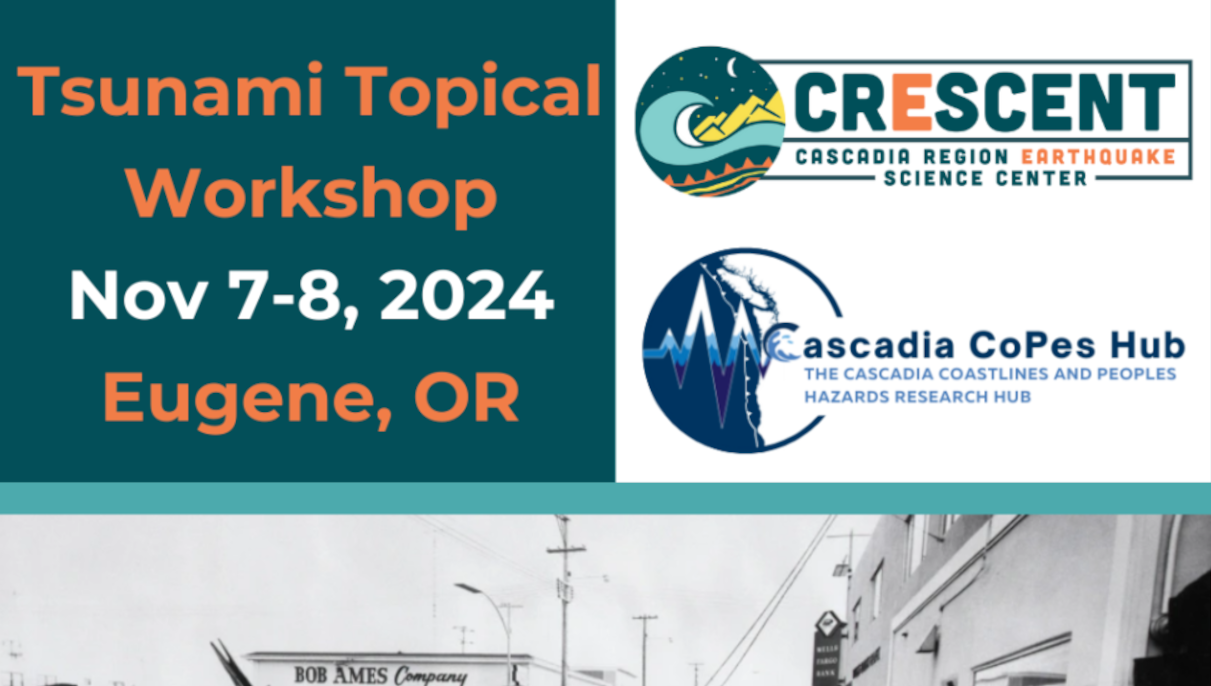The science of planning for future tsunamis

Insights from the 2024 CRESCENT Topical Workshop "From hazard to risk: The science of planning for future tsunamis".
Published on November 15, 2024 by Fabian Kutschera
tsunami workshop cascadia
5 min READ
I just returned from an exciting and very informative tsunami topical workshop “From hazard to risk: The science of planning for future tsunamis” as part of CRESCENT (Cascadia Region Earthquake Science Center) in collaboration with the NSF-funded Cascadia Coastlines and Peoples Hazards Research Hub (Cascadia Copes Hub). 46 attendees came together at the University of Oregon, Eugene, and reviewed state-of-the-art of tsunami risk assessments, scientific gaps, and technical advancements to be implemented in the future.
The cross-disciplinary workshop focused on, but was not limited to, the Cascadia subduction zone and addressed four core themes:
- Geophysics: science of earthquakes and tsunamis
- Probabilistic tsunami hazard assessment (PTHA): the methodology of how we quantify uncertain hazards
- Fragility analysis: from hazard to risk
- Implementation: How do our models/estimates make it into policy and industry applications?
Contributions to this workshop were made through a set of presentations, roundtable discussions, lightning talks, and posters. I myself presented a poster during this workshop on “Does source complexity govern tsunami generation?” (see conferences tab and the poster at the bottom of the page).
Here are selected key take-aways and lessons learned from the respective sessions of the workshop and following the discussions:
- Long paleoseismological records that span several earthquake cycles are vital and require a high-quality age control.
- Tsunami deposit mapping is a key benchmark for (dynamic) rupture models.
- Diatoms fossils, which are microscopic algae that help record environmental changes, can be used to better understand the impact of past earthquakes and tsunamis.
- Diatoms seem to be better suited than foraminifera when modeling the coseismic uplift/subsidence.
- There is strong evidence of no through-going megasplay fault offshore Washington or Oregon (Lucas et al., in review).
- Other, smaller splay faults exist and are active.
- During megathrust events, shallow slip is likely distributed onto multiple landward-vergent splay faults within the active domain of the outer wedge (Ledeczi et al., 2024), i.e., the outermost 30 km, which may add to seafloor displacement.
- The actual Cascadia subduction plate interface differs from Slab2.0 with more variable dip and along-strike steps suggesting segmentation of the megathrust.
- Locking to the “trench” is much more likely than not, while slip to the “trench” seems to be extremely likely.
- T-shirt size-based rupture scenarios (S, M, L, XL, XXL) are used by emergency planners in Oregon and Washington.
- Kinematic coupling and seismic coupling are two different concepts:
- Kinematic coupling specifies the ratio of slip deficit to long-term slip rate (with 1 = not slipping). Here, the slip rate deficit is given by the difference between the current slip rate and the long-term average.
- Seismic coupling specifies the fraction of slip released seismically (with 1 = totally seismic). Here, frictional locking is given by the fault’s response to slip.
- Slip rate deficit ≠ frictional locking.
- See e.g., Almeida et al. (2018) and Lindsey et al. (2021).
- More offshore data is needed to probe fault friction and other parameters.
- Homogeneous (and simplified) slip models might not capture the full range of possible earthquake behaviors.
- Source complexities affect the tsunami calculations significantly.
- Tsunamis are affected by tidal variations, climate change, and coastal erosion, which needs to be accounted for.
- Vulnerabilities are not stationary but change over time.
- Trailing waves (and not the leading wave) are sensitive to bathymetry errors (Sepúlveda et al., 2020):
- Higher sensitivity may be explained by shorter tsunami wavelengths and longer time during tsunami propagation.
- This point is also discussed by Kutschera et al. (2024).
- Real-world complexities such as barrier islands, which are dynamic systems involving lagoon, marsh, beach, and other barriers, are important to understand to estimate coastal hazards.
- Assessing debris flow following a tsunami remains challenging, but needs to be addressed.
- Physics-based models of earthquake generation and tsunami inundation should be incorporated into loss estimation.
- Better alignment between the National Tsunami Warning Center (NTWC) and the Pacific Tsunami Early Warning Center (PTWC) should be pursued.
- Improved understanding of tsunami hazard if key towards improved assessment of tsunami risk.
- Include higher resolution modeling for highest-risk tsunami scenarios.
If your browser does not support PDFs, please download the PDF to view it: Download PDF.
A huge thanks to the workshop planning committee, the organizers, and of course all participants. This concludes this blog post for now. No liability is taken for the accuracy, completeness or timeliness.
References
- Almeida, R., Lindsey, E. O., Bradley, K., Hubbard, J., Mallick, R., and Hill, E. M.: Can the Updip Limit of Frictional Locking on Megathrusts Be Detected Geodetically? Quantifying the Effect of Stress Shadows on Near-Trench Coupling, Geophysical Research Letters, 45, 4754–4763, https://doi.org/10.1029/2018GL077785, 2018.
- Kutschera, F., Jia, Z., Oryan, B., Wong, J. W. C., Fan, W., and Gabriel, A.-A.: The Multi-Segment Complexity of the 2024 Mw 7.5 Noto Peninsula Earthquake Governs Tsunami Generation, Geophysical Research Letters, 51, e2024GL109790, https://doi.org/10.1029/2024GL109790, 2024.
- Ledeczi, A., Lucas, M., Tobin, H., Watt, J., and Miller, N.: Late Quaternary Surface Displacements on Accretionary Wedge Splay Faults in the Cascadia Subduction Zone: Implications for Megathrust Rupture, Seismica, 2, https://doi.org/10.26443/seismica.v2i4.1158, 2024.
- Lindsey, E. O., Mallick, R., Hubbard, J. A., Bradley, K. E., Almeida, R. V., Moore, J. D. P., Bürgmann, R., and Hill, E. M.: Slip rate deficit and earthquake potential on shallow megathrusts, Nat. Geosci., 14, 321–326, https://doi.org/10.1038/s41561-021-00736-x, 2021.
- Sepúlveda, I., Tozer, B., Haase, J. S., Liu, P. L.-F., and Grigoriu, M.: Modeling Uncertainties of Bathymetry Predicted With Satellite Altimetry Data and Application to Tsunami Hazard Assessments, Journal of Geophysical Research: Solid Earth, 125, e2020JB019735, https://doi.org/10.1029/2020JB019735, 2020.